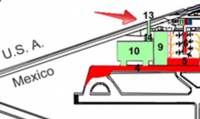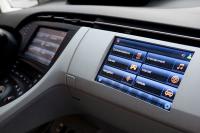-
TSA cuts to the PreCheck program will make security lines longer
Thanksgiving weekend was a busy one for the Transportation Security Administration (TSA), but holiday travelers passed through airports’ security linesrelatively quickly. In the coming Christmas and New Year traveling period, the cutbacks to the PreCheck lanes as well as the increasing number of passengers using air travel will both contribute to security lines growing longer.
-
-
Tijuana airport’s bridge-connected terminals straddle U.S.-Mexico border

The Tijuana airport is only the second airport in the world straddling an international border, with terminals on each side of the U.S.-Mexico border. Before the bridge opened, travelers had to drive a rental car or be driven in shuttle buses for about fifteen minutes to a crowded land crossing, where they often had to wait several hours to enter San Diego by car or on foot. On the new airport bridge, it takes passengers five minutes to walk to a U.S. border inspector.
-
-
More than 500 travelers to U.S. flagged daily for “national security concerns”
U.S. Customs and Border Protection (CBP) data show that every day, hundreds of travelers going through airports, seaports, and land border crossings are flagged for “suspected national security concerns.” In 2014, the average daily number of those flagged for national security concerns was 548.
-
-
Man uses stolen boarding pass to get through Utah airport security
A man who had stolen a boarding pass which was left by mistake on a Southwest Airline counter, managed to get through airport security in Salt Lake City, but was stopped at a gate for a flight to California. The attendants at the boarding gate became suspicious since the woman for whom the boarding pass was printed had been given a replacement pas and had already checked in.
-
-
Smart sensor detects single molecule in chemical compounds
Researchers have developed a smart sensor that can detect single molecules in chemical and biological compounds — a highly valued function in medicine, security, and defense. The researcher used a chemical and biochemical sensing technique called surface-enhanced Raman spectroscopy (SERS), which is used to understand more about the make-up of materials.
-
-
U.K. plans to boost counterterrorism, aviation security significantly

The U.K. government will substantially increase efforts to counter the threat from ISIS. In the five-year defense and security review, to be unveiled next week, the government details plans to increase the staff of MI5, MI6, and GCHQ by 1,900 officers; at least a double the funding for aviation security around the world; and deploy additional aviation security officers to assess security at overseas airports.
-
-
Protecting vehicles from cyberattacks

The Department of Homeland Security (DHS) Science and Technology Directorate (S&T) has awarded two grants for the development of technologies that can help defend government and privately owned vehicles from cyberattacks. “Modern vehicles are no longer purely mechanical systems,” said Dr. Dan Massey, S&T Cyber Physical Systems Security (CPSSEC) Program Manager. “Today’s vehicles have interdependent cyber components used for telematics, conveniences, and safety-critical systems. A stealthy adversary could gain access to a vehicle’s cyber components and remain completely hidden until initiating a widespread attack.”
-
-
Researching cyber vulnerabilities in computer-controlled cars may violate copyright law
The advent of computer controlled, Internet-capable vehicles is offering fertile new ground to hackers. Groups of “white hat” hackers have already demonstrated the vulnerabilities inherent in the new cars’ computer systems – by taking control over a car from ten miles away. One problem in addressing the issue is that the control software is proprietary, and is owned by the developers, and researching it to uncover flaws may be a violation of copyright laws.
-
-
U.S. to unveil drone registry plan in response to safety, security concerns
As part of the U.S. aviation authorities’ effort to tackle the growing safety and security problems posed by drones, U.S. drone will soon be required to register their aircraft with the Department of Transportation. The register, to be made public on Monday, comes in response to a surge in incidents in which drones have flown near airports and crowded public venues.
-
-
Expert passport officers better than face recognition technology in detecting fraud
Face-matching experts at the Australian Passport Office are 20 percent more accurate than average people at detecting fraud using automatic face recognition software, new research shows. The study is the first to test how well people perform on this difficult but common operational task carried out by passport officers. “Our research shows that accuracy can be significantly improved by recruiting staff who are naturally good at face recognition - the so-called “super-recognizers” — and then giving them in-depth training in the use of the software,” said the study lead author.
-
-
FAA expands efforts to tackle risk of drones near busy airports
A steep increase in reports of small unmanned aircraft in close proximity to runways is presenting a new challenge for the FAA. The Federal Aviation Administration (FAA) has entered into a Pathfinder agreement with CACI International Inc. to evaluate how the company’s technology can help detect Unmanned Aircraft Systems (UAS) in the vicinity of airports.
-
-
Airport X-ray screening systems comply with health and safety radiation exposure standard

Machines that use advanced X-ray imaging technology to screen airport passengers comply with radiation exposure limits set by the American National Standards Institute/Health Physics Society (ANSI/HPS), says a new report from the National Academies of Sciences, Engineering, and Medicine. The report also finds that the machines adhere to the recommended safety mechanisms described in the ANSI/HPS standards to prevent overexposure to radiation in the event of a mechanical failure or deliberate tampering.
-
-
TSA agents find record number of guns in carry-on luggage at airports
TSA agents discovered 67 guns in carry-on luggage during the week which ended 17 September. The tally for the week broke an earlier record of 65 firearms found during one week in May 2013. TSAofficers found nearly 1,900 firearms in carry-on luggage between 1 January and 31 August 2015. This year is thus on track to see a 28 percent spike in the number of firearms found compared to the 2,212 guns — an average of about 40 a week — discovered by TSA agents in 2014.
-
-
Residents of 4 states may need more than a driver license to board domestic flights
Residents of four states — New York, New Hampshire, Minnesota, and Louisiana – may soon need more than their driver’s licenses as a means of identification when boarding an aircraft for a domestic flight, DHS says. These states’ licenses do not meet the standards stipulated by DHS under the latest phase of the federal Real ID Act of 2005. Residents from these four states will have to present their passports with them, or some other means of DHS-approved identification, before being allowed on board.
-
-
Testing radiation detection systems in harsh conditions
Researchers from five laboratories and a private company recently spent two days in blistering 100 degree heat testing radiation detection technologies amidst cargo containers. The fifteen researchers demonstrated the feasibility of using gamma-ray and neutron imaging detectors to identify radioactive materials using the Lawrence Livermore National Laboratory’s (LLNL) cargo container stack testbed.
-
More headlines
The long view
New Technology is Keeping the Skies Safe
DHS S&T Baggage, Cargo, and People Screening (BCP) Program develops state-of-the-art screening solutions to help secure airspace, communities, and borders
